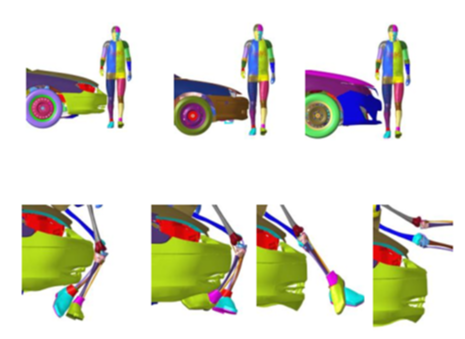Building on previous studies, this research investigates how vehicle design and anthropometric differences influence pedestrian lower-limb injuries during sedan collisions. By simulating crashes between three vehicle models (Taurus, Neon, Camry) and the Vietnamese-scaled V-THUMS pedestrian model, the team provides valuable engineering data to enhance vehicle front-end safety design.
Simulation and analytical framework
Each sedan model was simplified for computation efficiency while retaining accurate mass, center of gravity, and structural stiffness. Collisions were simulated at 40 km/h, focusing on bending moments, resultant forces, and ligament strain within the femur, tibia, and knee.
The Camry’s higher front-end profile resulted in more severe knee and thigh injuries, while the Taurus, having a lower bumper height, generated concentrated stress in the tibia. The Neon exhibited intermediate results but indicated similar risk levels for ligament damage.
Key biomechanical findings
- The maximum bending moments recorded were 170 Nm (femur) and 155 Nm (tibia) for Camry impacts.
- The resultant forces exceeded 4000 N in critical areas, surpassing international safety limits.
- Von-Mises stress analysis showed the tibia enduring stress up to 129 MPa, close to the cortical bone fracture threshold.
- Ligament strain in the knee joint (ACL, MCL, LCL, PCL) reached 22–28%, suggesting high rupture probability.
 Figure 1: Collision process set up. From right to left is Taurus, Neon and Camry
Figure 1: Collision process set up. From right to left is Taurus, Neon and Camry
These findings validate that vehicle height and bumper stiffness play crucial roles in determining pedestrian injury levels. By adapting designs to absorb energy progressively, manufacturers can significantly reduce pedestrian trauma.
Towards safer vehicle design
The research suggests adopting energy-absorbing front structures and deformable bumpers compatible with smaller body frames. When combined with localized pedestrian models like V-THUMS, such innovations could form the foundation for next-generation safety testing in Vietnam and Southeast Asia.
This study demonstrates the importance of cross-disciplinary approaches—bridging automotive engineering, biomechanics, and data simulation—to build vehicles that protect not just drivers, but every road user.